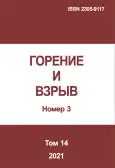Initiation of explosion by high voltage discharge of pressed mixtures of sevilene with ammonium perchlorate and nitrate with addition of powdered aluminum
- Autores: Rebeko A.G.1, Ermolaev B.S.1
-
Afiliações:
- N. N. Semenov Federal Research Center for Chemical Physics of the Russian Academy of Sciences
- Edição: Volume 14, Nº 3 (2021)
- Páginas: 122-129
- Seção: Articles
- URL: https://journal-vniispk.ru/2305-9117/article/view/288589
- DOI: https://doi.org/10.30826/CE21140311
- ID: 288589
Citar
Resumo
The use of a high-voltage discharge to initiate an explosion is justified when strict synchronization of actions is required. A typical working process, which is excited by a discharge, is detonation where high-power blasting explosives with the addition of nanodispersed metals are used to reduce the discharge voltage and increase the initiation stability. However, there are technical areas (here, one can mention the use in elements of dynamic protection of tanks and in promising hypersonic accelerators of the “blast wave accelerator” type) where nanodispersed metals are unacceptable due to their low stability and high cost and instead of normal detonation, softer explosive processes are required to exclude unnecessary blasting effect on the elements of the devices. In this work, the initiation of an explosion by a high-voltage discharge in pressed mixtures of ammonium perchlorate and ammonium nitrate with sevilene with additives of various metals has been investigated. Sevilen is a thermoplastic adhesive, a copolymer of ethylene and vinyl acetate, has excellent adhesion to all components of the studied mixtures, and provides excellent conditions for pressing samples. The best result: reliable explosions in a wide range of sample porosities up to a sample with a porosity of 1% at a threshold voltage of 5.5 to 1.5 kV were obtained using mixtures of ammonium perchlorate with the addition of 20% aluminum powder with a particle size of 10 m. The replacement of ammonium perchlorate with ammonium nitrate also demonstrates good results and with the addition of other metals (copper, iron, and zinc were studied), explosions were practically absent up to the maximum voltage of 12 kV used in the present work. The most probable reason: vigorous exothermic interaction of the aluminum melt formed during electrical breakdown with ammonium perchlorate. One can try to use this effect to replace nanodispersed aluminum with a powder with micron-sized particles during high-voltage initiation of detonation of powerful secondary explosives, if a certain amount of ammonium perchlorate is introduced into the mixture.
Sobre autores
Alexey Rebeko
N. N. Semenov Federal Research Center for Chemical Physics of the Russian Academy of Sciences
Autor responsável pela correspondência
Email: alex@akmeon.com
research scientist
Rússia, 4 Kosygin Str., Moscow 119991Boris Ermolaev
N. N. Semenov Federal Research Center for Chemical Physics of the Russian Academy of Sciences
Email: boris.ermolaev44@mail.ru
Doctor of Science in physics and mathematics
Rússia, 4 Kosygin Str., Moscow 119991Bibliografia
- Romanov, D. I., and V. V. Sten’gach. 1972. Sensitivity of petn to an electric spark. J. Appl. Mech. Tech. Ph. 13(6):891–893.
- Andreev, V. V., and L. A. Luk’yanchikov. 1974. Low-speed detonation machanism in a petn powder with spark ignition. Combust. Explo. Shock Waves 10(6):818–823.
- Andreev, V. V., A. P. Ershov, and L. A. Luk’yanchikov. 1984. Two-phase low-speed detonation in a porous explosive. Combust. Explo. Shock Waves 20(3):330–333.
- Luk’yanchikov, L. A. 2000. Initiation systems using secondary explosives. J. Appl. Mech. Tech. Ph. 41(5):806–817.
- Danilenko, V. V. 2010. Vzryv — fizika, tekhnika, tekhnologiya [Explosion — physics, engineering, technology]. Moscow: Energoatomizdat. 40 p.
- Bragin, V. A., S. A. Dushenok, V. G. Kulikov, G. G. Savenkov, and G. V. Semashkin. 2012. Influence of metal nanopowders on the sensitivity of explosives to a high-voltage electric discharge. A fractal-percolation approach. Russ. J. Phys. Chem. B 6(3):390–396.
- Rashkovskii, S. A., and G. G. Savenkov. 2013. Initiation of detonation by a high-voltage discharge in powdered explosives with nanosize inert admixtures. Tech. Phys. 58(4):511–522.
- Tarasenko, A. A. 2007. Kompleksnaya zashchita bronetankovoy tekhniki [Complex protection of armored vehicles]. Tekhnika i vooruzhenie [Technics and Weapons] 2:10.
- Wilson, D., Z. Tan, and P. L. Varghese. 1996. Numerical simulation of the blast-wave accelerator. AIAA J. 34(7):1341.
- Ermolaev, B. S., A. A. Belyaev, A. V. Roman’kov, V. E. Khrapovskii, A. A. Sulimov, and A. G. Rebeko. 2019. Behavior of low-velocity detonation in stoichiometric mixture of ammonium perchlorate and polyamethyl methacrylate. Russ. J. Phys. Chem. B 13(4):646–656.
- Ermolaev, B. S., B. A. Khasainov, A.-N. Prel, P. Vidal, and A. A. Sulimov. 2005. Nizkoskorostnaya detonatsiya v nitrate ammoniya i smesyakh na ego osnove [Low-speed detonation in ammonium nitrate and mixtures based on it]. 13th All-Russian Symposium on Combustion and Explosion. Chernogolovka. Report No. 155 (electronic version).
- Khrapovskii, V. E., B. S. Ermolaev, A. A. Sulimov, A. A. Belyaev, and V. A. Foteenkov. 2007. Convective burning of pressed aluminum–ammonium perchlorate charges. Russ. J. Phys. Chem. B 1(1):27–38.
- Khudaverdiyev, V. G., A. A. Sulimov, and V. E. Khrapovskii. 2014. O perekhode goreniya v detonatsiyu v melkodispersnykh smesyakh perkhlorata ammoniya s alyuminiem [Deflagration-to-detonation transition in fine mixtures of aluminum with ammonium perchlorate] Goren. Vzryv (Mosk.) — Combustion and Explosion 7:395–399.
- Kryzhanovsky, V. K., V. V. Burlov, A. D. Panimatchenko, and Yu. V. Kryzhanovskaya. 2003. Tekhnicheskie svoystva polimernykh materialov [Technical properties of polymeric materials]. St. Petersburg: Publishing House “Profession.” 34 p.
- Rebeko, A. G. 2015. Sposob izgotovleniya zaryada RDTT iz smesevogo raketnogo topliva [A method of manufacturing a solid propellant rocket charge from a composite rocket fuel]. Patent RF No. 2626353.
- Nelson, L. S., M. J. Eatough, and K. P. Guay. 1989. Why does molten aluminum explode at underwater or wet surfaces? Light Met. 3:1057.
- Nelson, L. S., S. R. Hogelandb, and T. C. Roth. 1999. Aluminum-enhanced underwater electrical discharges for steam explosion triggering. Albuquerque, NM: Sandia National Labs. Report No. SAND99-0796. 45 p.
Arquivos suplementares









